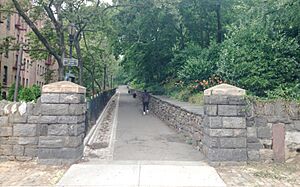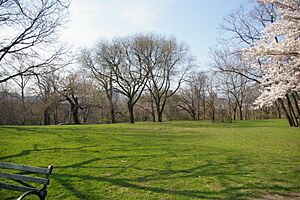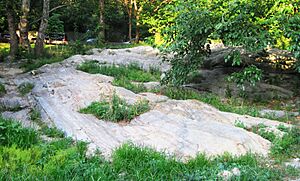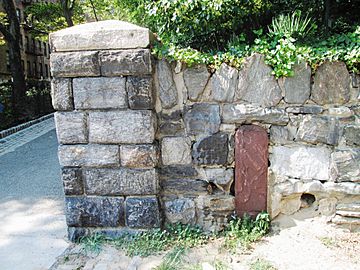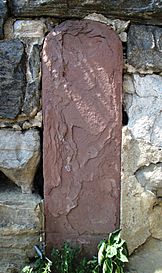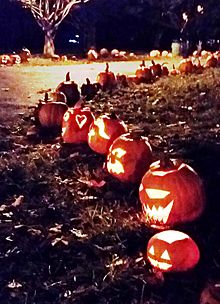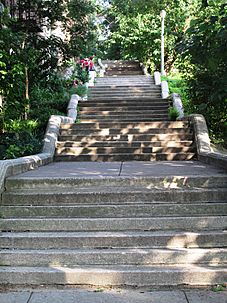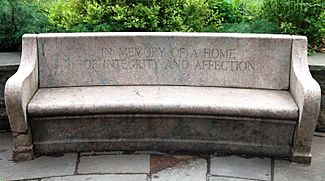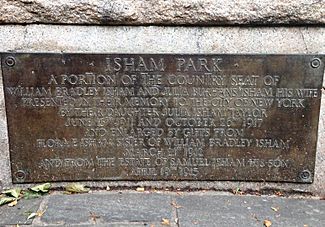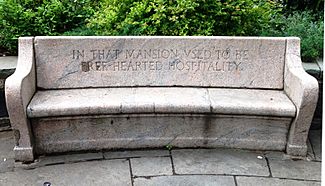Isham Park facts for kids

Isham Park is a 20-acre historic park located in Inwood, a neighborhood in Manhattan, New York City. The park was mostly created from land given to the city by the Isham family, from their old family estate. It sits between Broadway, Isham Street, Seaman Avenue, and West 214th and 215th Streets.
The park used to stretch all the way to the Harlem River. But after Inwood Hill Park was created and local streets were changed, Isham Park's main border became Seaman Avenue. However, the baseball fields across Seaman Avenue are still considered part of Isham Park. The size of the park today is about the same as the original Isham family estate. The old Isham mansion, which came with the park gift, was torn down in the 1940s because it was in bad shape.
At its southern end, Isham Park is famous for its exposed marble rocks. These rocks are incredibly old, dating back to the Cambrian period, which was hundreds of millions of years ago! College geology classes often visit this spot. There is also a public garden in the park's northeastern corner. While much of the park has wild trees and bushes, the center of the park, at the top of a hill, is a nice grassy lawn.
Park History
William Bradley Isham (pronounced EYE-sham) was a very successful leather merchant and businessman. He was also a vice-president of a bank and president of a mortgage company. Mr. Isham was a generous supporter of many important places like the American Museum of Natural History and the Metropolitan Museum of Art. He lived in a fancy house on East 61st Street in Manhattan.
In 1862, Mr. Isham rented a house in what is now Inwood as a summer home. The two-story house was built in the 1850s and had a unique cross shape with four wings. This design allowed for lots of light and fresh air. Because the house was on a hilltop, it had amazing views of both the Hudson River and the Harlem River, and always caught cool breezes.
Two years later, Isham bought the property as his summer estate. It was 24 acres and included the house, a greenhouse, a gardener's cottage, a stable, and a cold spring. This spring was one of the few natural sources of fresh water in the area. William's son, Samuel, later described how his father improved the estate. He cleared the land, moved the stable, and planted many of the trees that are still there today.
The Old Milestone
When Mr. Isham was building a wall along the Broadway side of his estate, a worker found an old stone marker. This marker, called a milestone, said "12 Miles from New York." It used to stand on the Kingsbridge Road, which is now Broadway. Mr. Isham had the milestone built into the wall near the estate's entrance, and it's still there today! Unfortunately, because the stone was soft, all the original words have worn away over time.
Isham used his property as a farm, but mostly for fun, not to make money. It's said that he harvested the very last wheat grown on Manhattan Island. Some of this wheat was even sent to the 1893 Chicago World's Fair.
From Estate to Park
William Isham passed away in 1909. In June 1911, his daughter, Julia Isham Taylor, gave almost 6 acres of the estate to New York City. She asked that it be made into a park named after her father. Her aunt, Flora E. Isham, also gave land the next year. In September 1912, over 5,000 people celebrated the new park with a parade, speeches, and folk dances by children.
More land was added to the park over the years. In 1915, William's son, Samuel, left more land to the city in his will. In 1917, Julia Isham Taylor bought more land, including the famous marble outcrop, and gave it to the park. The city also bought more land in the 1920s to expand the park.
The Isham house was part of the gift to the city. For many years, it was used for community activities, like a museum. However, because the house was in poor condition, it was torn down in the 1940s.
At one point in the 1930s, a World War I cannon was placed in the park. But in 1943, during World War II, the cannon was removed to be melted down and reused for the war effort. Children who played there were told it would be replaced after the war, but it never was.
A special plaque in the park tells the story of how the park was created. It reads:
Isham Park
A Portion of the Country Seat
of William Bradley Isham and Julia Burnans Isham his Wife
Presented in their memory to the City of New York
By their daughter Julia Isham Taylor
June 15th 1911 and October 26th 1917
And enlarged by gifts from Flora E. Isham, sister of William Bradley Isham
March 21st 1912
and from the estate of Samuel Isham his son
April 19th 1915
The park celebrated its 100th birthday on September 29, 2012!
Annual Events
Isham Park is a popular spot for neighborhood gatherings. Local residents organize two fun, family-friendly events each year:
- The Isham Park Egg Hunt is held every spring around Easter.
- The Inwood Pumpkin Pageant takes place every November 1st, where the community displays their Halloween jack-o'-lanterns.
Both events bring hundreds of people from the area to the park. Many other seasonal events, like concerts and gardening activities, are also held in and around Isham Park.
Park Boundaries
Isham Park has interesting borders.
- Its southeastern edge is Broadway.
- The southwest border follows the backyards of buildings on Isham Street and then Isham Street itself to Seaman Avenue.
- The northwest border is mostly Seaman Avenue. However, the baseball fields across Seaman Avenue are still considered part of Isham Park, not Inwood Hill Park.
- The northeast boundary is a bit tricky. Part of it is West 214th Street, which is actually a set of stairs, not a regular street! Other parts follow the property lines of nearby buildings.
Gallery
-
The plaque mentioned above is situated opposite from the two marble benches.


